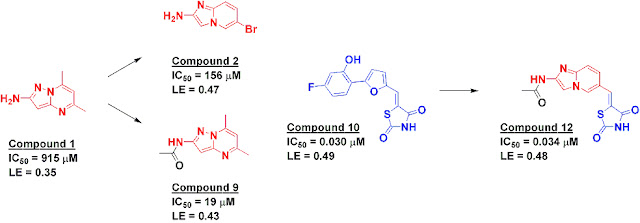Zenobia Therapeutics hosted
a one-day FBLD meeting in San Diego last Friday. It was a very full day of seven talks and plenty of informal discussion, with both lunch and happy-hour on a rooftop terrace overlooking the ocean. I’ll try to give some flavor of the event below – those of you who were there, please chime in with your own impressions.
In the first talk of the day, Michael Recht of Xerox’s PARC discussed the construction and use of array-based nanocalorimetry devices, which analyze samples as small as a couple hundred nanoliters. Although conceptually related to
isothermal titration calorimetry, the scale of nanocalorimetry makes direct measurement of binding enthalpy difficult. However, the devices are well-suited to measuring the heat output from enzymatic reactions, thus allowing detailed study of enzyme kinetics and inhibitor characterization (see
here for a full description and
here for a review, both open-access).
Maurizio Pellecchia of the Sanford-Burnham Medical Research Institute gave a wide-ranging talk with the common theme of NMR as an enabling method. In particular he noted that, due to its low protein requirements, ILOE (which we’ve
written about previously) could be considered the “homeopathy of NMR;” a
recent paper in
J. Med. Chem. describes its application to generate hits against Bcl-family proteins. He used a different NMR technique to discover a potent and selective
JNK inhibitor that binds in both the ATP and substrate binding sites. On a completely different topic, Maurizio noted that roughly one-third of drug targets contain metals, prompting the construction of a fragment-library designed with metal-chelation in mind, a strategy
we’ve written about previously (see also
here). Many of these techniques and libraries have now been licensed into a new company,
AnCoreX Therapeutics, founded by Maurizio.
Schrödinger was a major sponsor of the meeting, and company scientist Kathryn Loving gave a good overview of the potential of their suite of software tools for fragment-based lead discovery. After lunch I presented a PDK1 story (see
here) as well as applications of
Carmot’s Chemotype Evolution, and Michelle Arkin from UCSF discussed some of the capabilities of the university’s Small Molecule Discovery Center, with special focus on protein activators and protein-protein disruptors.
Tony Giannetti of Genentech gave a nice presentation on caspase-6 inhibitors and also discussed the power of
SPR, a topic on which
he’s written extensively. He noted that as long as one is careful about conducting the experiment, the number of promiscuous or non-specific binders found by SPR tends to be less than the number of true hits – he described the former as “a managed headache.”
Tony is in the enviable position of having screened numerous targets using the same platform, allowing him to do some very interesting data mining. One phenomenon that
we’ve previously commented on is the fact that, across multiple companies, only about a third of fragments hit in one or more screens, and Roche is no exception (36% across 13 screens). With the merger of Genentech and Roche now complete, Tony has been able to compare the fragment libraries assembled separately at each institution. Interestingly, although they contain < 5% common fragments and < 10% similar fragments, the libraries are, by broad measurements such as size or lipophilicity, statistically indistinguishable. However, the hits from the Roche collection seem to have higher ligand efficiencies. Also, the most potent binders tend to have 13-17 atoms, with the most ligand-efficient molecules generally having a molecular weight < 200. Finally, there has been
a lot of recent discussion on making fragments less flat (aromatic) and more three-dimensional (often aliphatic). However, as
I predicted 2 years ago, one needs to be cautious: it turns out that hits were actually enriched for flatter fragments, although Tony did mention that most of the screens were against kinases, which may be particularly “flatophilic”.
Vicki Nienaber, founder and president of Zenobia, closed the conference by discussing the potential for fragment-based approaches to tackle diseases of the central nervous system (CNS). The rationale is that, since CNS drugs need to be small to cross the blood-brain-barrier, it pays to start with fragments. Indeed,
Zenobia’s fragment library has a molecular weight averaging just 150-175, with an upper limit of 225, which should allow them to avoid
molecular obesity. Vicki described the discovery of nanomolar leads against LRRK2, a Parkinson’s disease target, and against PDE10, a Huntington’s disease target.
As far as I know this was the last face-to-face fragment event this year, but there are still several webinars this month and next, and it’s not too soon to start planning for 2012; please see
here for upcoming events.











